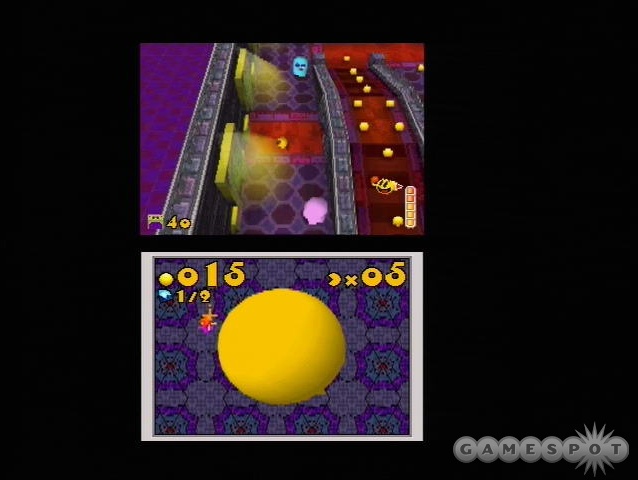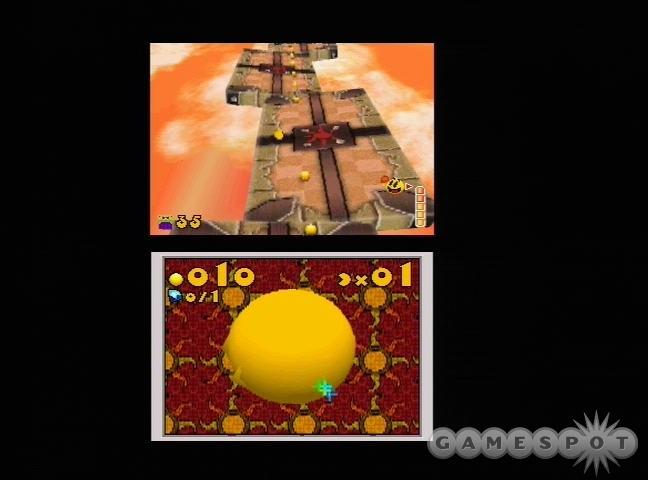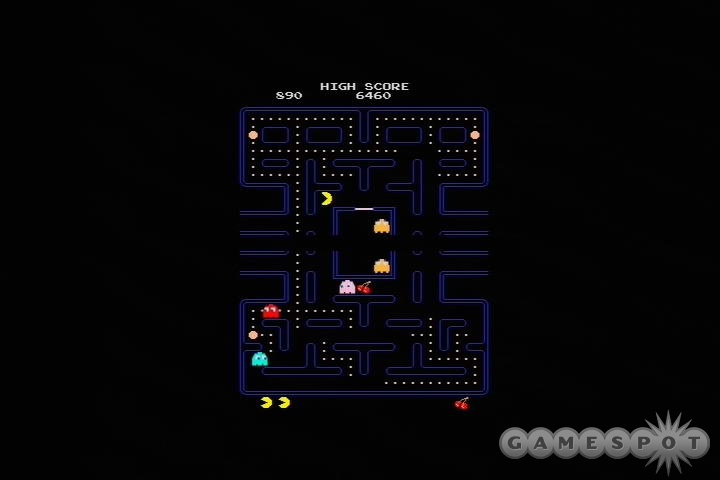Namco's yellow-dot chomper is all but synonymous with classic video games, but Pac-Man's transition into modern gaming has yielded mixed results. Whether it's been in platforming, party, or the puzzle genre, Pac-Man games in recent years have never captured the magic that made the original games so iconic over the decades. Nonetheless, Namco has dutifully forged ahead with Pac-Man spin-offs, and its latest is Pac 'n Roll for the Nintendo DS. The game is part puzzler, part platformer and it offers a decent implementation of the stylus and touch screen for control. Unfortunately, the novelty of the interface can wear thin, despite some different wrinkles in gameplay that you encounter over the course of the game.

Pac 'n Roll's unusual design premise is explained by its plot. An evil superghost named Golvis has arrived to terrorize Pac-Land. Golvis has captured the area hero, Pac-Master, as well as Pac-Master's family, by turning them into limbless and helpless balls. As Pac-Man, Pac-Master's hero apprentice, you also fall under Golvis' curse but manage to escape capture. With the assistance of a helpful fairy, you must take on Golvis and his ghosts across several different worlds in order to rescue each member of Pac-Master's family and restore everyone to their normal state. Each of the game's more than two dozen stages requires you to roll around and collect dots and jewels while navigating tricky mazes, dodging ghosts, and avoiding environmental hazards. This gives the game its puzzler-platformer feel, sort of like a cross between Marble Madness and Sonic the Hedgehog.
The top screen of the DS shows you the playing field, while the bottom screen shows Pac-Man's smiling face. You'll use the stylus to move across the bottom screen, which will roll Pac-Man around the level as though you were using a trackball. You can also rotate the camera around using the D pad or the face buttons. And that's the extent of the control scheme.
The implementation of this design conceit is good for the most part. You can build up a fair amount of speed by using long, deliberate strokes. You also have the ability to do a speed burst, which is useful for running away from ghosts, shooting up ramps, or breaking open boxes. There's also a palpable feel of momentum, which changes depending on whether or not you've picked up either of the two modifier items: a suit of armor, which weighs you down and lets you sink in water or break open metal boxes; or a feather cap, which makes you extremely light, letting you float for short distances but also rendering you vulnerable to blowing away in gusts of wind. The designers have also thoughtfully included a fail-safe method for falling off of ledges. If you're not speed bursting, you'll need to swipe the stylus an extra time at the lip of the ledge to actually drop off of it. The problem with the control scheme comes in the later levels when you're required to carefully control Pac-Man and perform a lot of abrupt changes in direction. Since the touch pad recognizes longer strokes more easily than shorter ones, it feels cumbersome as you execute deliberate control and change in direction, which are required of you in later levels.

Within a specific level, Pac 'n Roll plays not unlike classic Pac-Man. You roll about and collect dots while trying to avoid ghosts that are wandering around. The ghosts will actually chase you a short distance when they detect you, but you can turn the tables on them by munching a power pellet and eating them while they're vulnerable. Unlike regular Pac-Man, the ghosts here generally don't respawn after you eat them, so it's very much to your advantage to find power pellets and then gobble up those ghosts. The dots you collect are used to open "Golvis gates," which separate the subareas of each level. You usually don't have to collect all the dots in a subarea to open the next Golvis gate, but collecting all the dots in a level before triggering the goal will reward you with a jewel and a perfect rating if you're playing in the story mode. The jewels, which can also be found in hidden areas, unlock challenge modes of the various levels as you collect them, as well as other content, including the original Pac-Man.
Each of the levels can be played in story mode, time trial, or challenge mode. Time trials merely challenge you to get through a level in the fastest time possible, while the challenge modes give you specific objectives, such as not eating a certain number of dots, or eating a specific number of ghosts before you can reach the end of the level. Much of the challenge in each level lies in its design. The hazards of the game really depend a lot on the theme of the world in which you're playing at that time. The levels in the jungle world hide a lot of dots underwater, requiring you to find suits of armor so you can go below and reach them. The flaming fortress level consists of a lot of elevated, moving passageways and platforms, making for some tricky jumps and navigation. The variation in the levels is nice, and none of the individual levels takes more than a couple of minutes to do. The later levels that require detailed control can get a bit frustrating because of the way the controls are implemented, but this still doesn't make the game overly difficult. One disappointing aspect is that the last level of each world is a boss fight, but it's always Golvis, and defeating him is pretty much always the same procedure, so there's not as much variety there as you'd hope.

Pac 'n Roll's presentation values are decent, but not great. The level textures and edges seem somewhat fuzzy, lacking the sharpness we'd have hoped for from a relatively simple game like this. The thematic differences between each of the worlds is quite pronounced, but other than that, there isn't very much going on in the levels as far as backgrounds or objects. The music in the game is usually pretty catchy, but this is more than offset by the irritating gibberish voices used in the cutscenes. A narrated comic book-style presentation is used to advance the story as you go from world to world, but the baby talk used by the characters can grate on your ears.
Namco's latest Pac-Man spin-off does an acceptable job at translating the Pac-Man theme to the Nintendo DS, taking good advantage of the system's unique strengths. In the end, however, there just isn't all that much depth to Pac 'n Roll. But if you're looking for a puzzler/platformer that will suffice for killing a few minutes at a time, you can do a lot worse than this game.